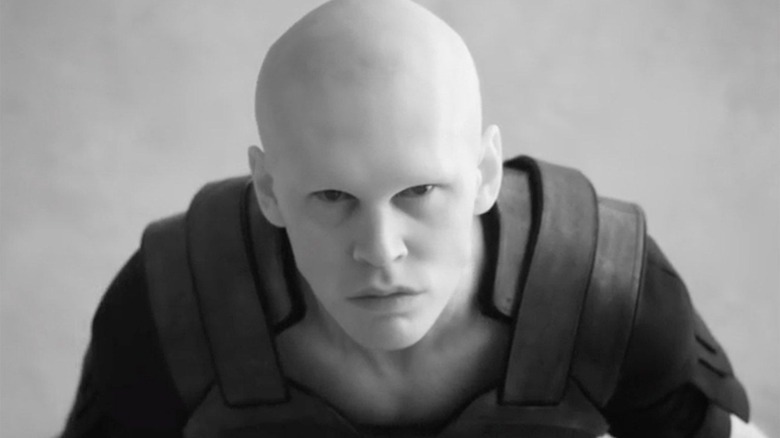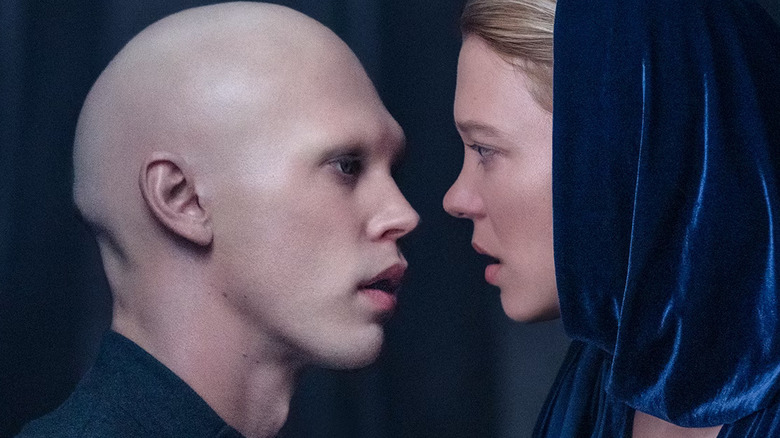Why Denis Villeneuve Made Austin Butler's Feyd-Rautha Bald In Dune: Part Two
In Frank Herbert's 1965 novel "Dune," Feyd-Rautha Harkonnen — the nephew of the villainous Baron Vladimir Harkonnen — is often presented as a royal counterpart to Paul Atreides. The Atreides and the Harkonnens have long been rivals, and the central conflict of "Dune" sees the two families vying for control of the planet Arrakis, the only known source of a valuable spice that makes space travel possible. After the Harkonnens slaughter most of the Atreides in a sneak attack, Paul flees into the deserts of Arrakis with his mother. While in the desert, Paul falls into the company of the Fremen, the Arrakis natives. Through a series of rituals and displays of leadership, Paul becomes a messianic figure for the Fremen, the Kwisatz Haderach.
At the end of the book, Paul returns to the occupied capital of Arrakis and is forced to fight Feyd-Rautha in an arena. Feyd is devious, cruel, and vicious.
In David Lynch's 1984 film adaptation of "Dune," Feyd was played by Sting and presented as a smirking twink in leather bikini shorts. All of the Harkonnens in Lynch's "Dune" had red hair. This stands in contrast to Feyd's physical description in the original novel, which saw him as having long dark hair and kind of a round, baby face. In Denis Villeneuve's new film "Dune: Part Two," Feyd will be played by Austin Butler, and the characters will sport pale skin, blackened teeth, no eyebrows, and a hairless pate. Indeed, one might note that none of the Harkonnen characters in Villeneuve's "Dune" movies have any hair.
It seems that this was a character decision on the director's part. In a recent interview with Vanity Fair, Villeneuve pointed out that in his vision of Herbert's story, the Harkonnens had a penchant for laser hair removal.
The bald Harkonnens
In Villeneuve's words:
"I loved the idea that Harkonnens are a society that doesn't like hair. [...] They remove everything. They want to be as far away from any part of their past as possible, where they are coming from. There's a will of purity."
Shaving one's head has long been a purification ritual in many religions, notably among certain Buddhist monks. The Harkonnens, however, aren't depicted as being particularly spiritual — indeed, they are hedonistic and cruel — so Villeneuve was likely evoking the panicked, commercially connected hair-removal rituals that began to invade the Western world in the early 20th century. The fashion of shaving one's armpits didn't come into vogue until Harper's Bazaar began hyping it in around 1915. Ever since, both men and women have been encouraged by Madison Avenue to remove more and more of their body hair, in a misguided attempt to look more feminine, "cleaner," and/or youthful. The complete removal of Harkonnen body hair in "Dune" likely shows that the family has deliberately taken those commercially-driven notions of vanity to their extreme.
In order to make Butler bald, the "Dune" makeup artists outfitted him with a latex bald cap. Butler described the makeup like this:
"There's two caps on my head. [...] One that goes over the hair, and then there's the sculpted cap that attaches kind of where my eyelids were, right at the crease of my eyelids. That goes all the way back."
Feyd's pronounced brow, as seen in the picture above, is artificial. One can only imagine how hot Butler became wearing the latex bald cap while shooting in the desert.
"Dune: Part Two" opens in theaters on March 1, 2024.

